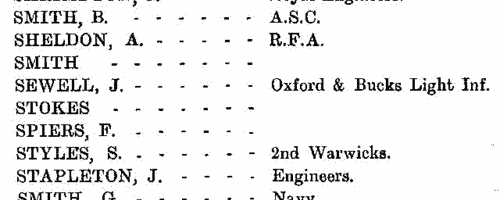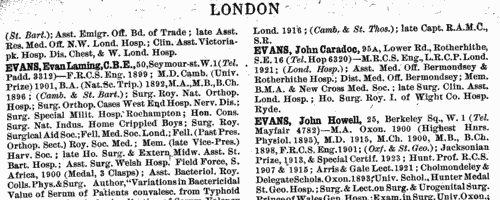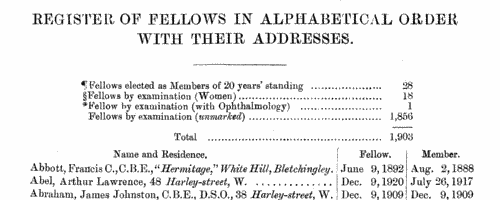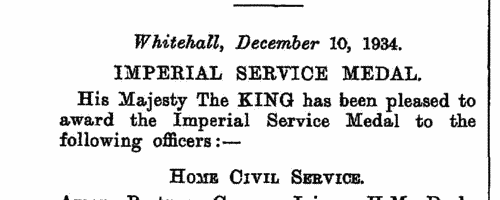Add this eBook to your basket to receive access to all 290 records. Our indexes include entries for the spelling foy. In the period you have requested, we have the following 290 records (displaying 251 to 260): These sample scans are from the original record. You will get scans of the full pages or articles where the surname you searched for has been found. Your web browser may prevent the sample windows from opening; in this case please change your browser settings to allow pop-up windows from this site. Workers from The New Conveyor Company Ltd of Brook Street, Smethwick, who fought in the Great War
(1919)
The Roll of Honour for the firm lists the men who joined his Majesty's forces, giving for each his surname, initials, rank and regiment. | Sample scan, click to enlarge

| Workers from Wolseley Motors Ltd of Adderley Park, Birmingham, who fought in the Great War
(1919)
The Roll of Honour for the firm lists the men who joined his Majesty's forces, giving for each his surname, initials, and (usually) regiment. | Sample scan, click to enlarge

| Medical Practitioners in Ireland
(1926)
The Medical Directory was split into several sections. The Irish section covered all medical practitioners resident within the whole of the island of Ireland. Each year a schedule was sent to each doctor to be returned to the publishers, so as to keep the directory up to date. In the directory the doctor's name is given first, in bold, surname first, in capitals; then current address. Next are the qualifications; the italic abbreviations in parentheses following the qualifications indicate the medical school at which they were gained. Then there is a list of posts and honours within the profession, starting with those then current; previous posts are preceded by the word 'late'. Finally, brief details are given of any publications. | Sample scan, click to enlarge

| Medical Practitioners in London
(1926)
The Medical Directory was split into several sections. The London section covered all medical practitioners resident within the London postal district. Each year a schedule was sent to each doctor to be returned to the publishers, so as to keep the directory up to date. In the directory the doctor's name is given first, in bold, surname first, in capitals; then current address. Next are the qualifications; the italic abbreviations in parentheses following the qualifications indicate the medical school at which they were gained. Then there is a list of posts and honours within the profession, starting with those then current; previous posts are preceded by the word 'late'. Finally, brief details are given of any publications. | Sample scan, click to enlarge

| Medical practitioners qualified in Britain or Ireland but living abroad
(1926)
The Medical Directory was split into several sections. The Practitioners Resident Abroad section covered all medical practitioners who, having qualified in Britain or Ireland or otherwise registered under the medical Acts of Great Britain and Ireland, were living abroad. Each year a schedule was sent to each doctor to be returned to the publishers, so as to keep the directory up to date. In the directory the doctor's name is given first, in bold, surname first, in capitals; then current address. Next are the qualifications; the italic abbreviations in parentheses following the qualifications indicate the medical school at which they were gained. Then there is a list of posts and honours within the profession, starting with those then current; previous posts are preceded by the word 'late'. Finally, brief details are given of any publications. | Sample scan, click to enlarge

| Public health specialists
(1928)
The Royal College of Surgeons, established by royal charters, issued this calendar 1 August 1928, including official lists of all its fellows, members, licentiates and diplomates. The register of fellows gives full name (surname first) and address (in italics), with dates of admission as fellow and member. The list of members gives year of admission, full name (surname first) and town or country of residence. The lists of licentiates give year of admission and full name, but no indication of current address: entries of fellows of the college are prefixed with a double dagger, those of members with an asterisk. The lists of diplomates give year of admission and full name (surname first), with those diplomates who were neither members nor fellows of the college indicated with a dagger. This is the index to the diplomates in public health (a qualification granted conjointly with the Royal College of Physicians of London). | Sample scan, click to enlarge

| Anglican clergy
(1930)
Crockford's Clerical Directory listed all Anglican clergy in the British Isles, India, the colonies, Europe, Asia and South America. The 59th annual issue, for 1930, is based on returns from all the individuals listed. The details given are: name (surname first, in capitals) in bold, prefixed by an asterisk in the case of university electors, and by a dagger whether the return had not been made, or it had been imperfectly filled up; name of theological college and/or university, and degrees, with years; a bold d followed by year and diocese signifies date of ordination as deacon and by which bishop; then a bold p, similarly for ordination as priest; posts (C: curate; I: incumbent; V; vicar; R: rector) with parishes and years; address; telephone number; and lists of books &c. where appropriate. In the case of the man then holding an English, Irish, Scottish or Welsh benefice, additional details are given - a bold P signifies the patron of the advowson; then the income, with items such as Q. A. B. (Queen Anne's Bounty), Eccles(iastical) Comm(issioners), Fees, e. o. (Easter Offerings), Pew Rents, T(ithe) R(ent) C(harge), Gl(ebe), &c. | Sample scan, click to enlarge

| Scientific Poultry Breeders
(1932)
The Scientific Poultry Breeders Association was by far the largest poultry society in Great Britain, with 16,109 members for the year 1930-1931. This seventeenth annual register, for the year 1932, lists members alphabetically by surname and initials, with addresses. P. F. stands for Poultry Farm. | Sample scan, click to enlarge

| Imperial Service Medal
(1934)
Awards by king George V of the Imperial Service Medal to officers of the Home Civil Service. The names are arranged alphabetically by surname and christian names, with office or rank in the service. | Sample scan, click to enlarge

| Officers of the British Army and of the Indian Army
(1934)
The Half-Yearly Army List, issued By Authority, 30 June 1934, lists all officers in active service at that date, and this list was evidence of the status and rank of the officers contained in it. The entries are set out as a gradation list, by rank, from field-marshals to lieutenants, and within each rank in order of seniority at that rank. Each officer's name (surname first, in capitals, then christian name and present rank (with date of achieving that rank) and regiment &c. are given, for convenience, in bold type, with any national decorations in italics after the name. Each entry also gives date of birth, number of days service in the ranks, dates of service in each rank of officer, particular offices and postings (with dates) and, where appropriate, a summary of war service, and medals. For all but the oldest of the officers then serving, the war service details are for the Great War (1914-1921), and campaigns in Iraq, Waziristan, and the North West Frontier of India. War services are not given in this edition for Indian Army officers, except in that their entries are preceded by a crossed swords symbol where they have seen war service in a theatre of war overseas. After the gradation list of officers, there is a section for the Royal Malta Artillery; and then (pages 1152 to 1185) warrant officers - staff or garrison serjeant-majors, educational serjeant-majors, serjeant-major (physical training and educational) instructors, regimental serjeant-majors (and corporal-majors, farrier-serjeant majors, master gunners, assistant instructors in gunnery, experimental serjeant-majors, artillery clerks, farrier-serjeant-majors, artificer serjeant-majors, clerks of works, mechanist, superintending clerks, draughtsmen, 1st class staff serjeant-majors, transport, supply, conductors, sub-conductors, armourers, armament artificers, headmasters, schoolmasters, marine gunners, and bandmasters. The section for the Royal Army Chaplains' Department lists all chaplains (1st to 3rd class); and that for Queen Alexandra's Imperial Military Nursing Service has all matrons, sisters and staff nurses. The lists of nurses do not give date of birth: all are unmarried. The book concludes with the Yeomen of the Guard, the Honourable Company of Gentlemen-at-Arms, and the King's Body Guard for Scotland, in each case giving name (surname and initials, not christian names), honours, name of late regiment, and date of appointment.
| Sample scan, click to enlarge

|
Research your ancestry, family history, genealogy and one-name study by direct access to original records and archives indexed by surname.
|











